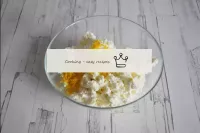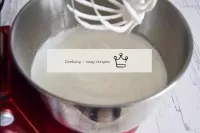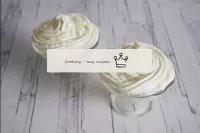Curd mousse with gelatin
 3 servings
3 servings2 hours 30 min
Gelatin for mousse can be used not only powder, but also in plates. In this case, you need to fill the plates (take the same amount by weight as the powder) with cold water and leave for 10 minutes. Moreover, the colder the water, the less likely it is that the protein in gelatin will begin to break down, and you will lose some of its strength. It is safest to use ice water. Squeeze the swollen gelatin. Then the squeezed sheets must be put in a pan of boiling water (40 ml) and put it on a small heat. Water with gelatin should be constantly interfered with until the liquid changes its viscosity. The finished mixture must first be cooled to about 45 degrees. Instead of water, you can use some of the cream that is needed to beat. But then your mousse will turn out to be more viscous, because it will have less fluid and gelatin will "grab" all the ingredients more strongly.
Cream - 300 mL, Cottage cheese - 200 g, Sugar - 120 g, Water - 40 mL, Gelatin - 8 g, Zest - 10 g
How to beat cream correctly? It is important that the cream is fat, at least 33%. Whipping utensils and the cream itself should be cold, hold them for at least 1-2 hours in the fridge. Beat with a mixer at minimum RPM, gradually increasing the speed. How do you know that the cream is whipped enough? The cream mass should maintain its shape and not spread. Stop whipping at this point. Otherwise, the cream will turn into oil.
To make a dish using gelatin, be sure to soak the gelatin in cold boiled water first. The colder the water, the better. The leafy gelatin can simply be put in a bowl of water. Before soaking the powdered gelatin, first rinse the dishes with cold water so that the crystals do not stick to the bottom. It is important to pour water on the powdered gelatin, and not to pour it into the water. Otherwise, lumps cannot be avoided. Then allow time for the gelatin to swell (exact time indicated on the package). The swollen gelatin is heated to 70-80 degrees. In no case should it be brought to a boil! . At a temperature of 100 ° C, the mass becomes fibrous and viscous, collagen protein breaks down and gelatin loses its jelly-forming properties.
 Español
Español Français
Français Português
Português Русский
Русский 简体中文
简体中文 繁體中文
繁體中文 日本語
日本語 한국어
한국어 العربية
العربية Türkçe
Türkçe Қазақ
Қазақ Deutsch
Deutsch Italiano
Italiano Українська
Українська
 How to make curd mousse with gelatin? Prepare the right ingredients. Take cottage cheese about 5-9% fat, and cream - at least 33% (they should be cold). Wash the lemon and roll with boiling water. Then dry with wipes. Grate his zest on a fine grater.
How to make curd mousse with gelatin? Prepare the right ingredients. Take cottage cheese about 5-9% fat, and cream - at least 33% (they should be cold). Wash the lemon and roll with boiling water. Then dry with wipes. Grate his zest on a fine grater.  Soak the gelatin in cold water and leave to swell for 15 minutes. Then dissolve the gelatin over low heat until its grains are completely dissolved. But since gelatin is very different, prepare it according to the instructions on the package!
Soak the gelatin in cold water and leave to swell for 15 minutes. Then dissolve the gelatin over low heat until its grains are completely dissolved. But since gelatin is very different, prepare it according to the instructions on the package! Combine the curd with the grated lemon zest in a separate bowl. Beat the resulting mass with a blender until uniform. Beat gently so that the mass does not scatter to the sides.
Combine the curd with the grated lemon zest in a separate bowl. Beat the resulting mass with a blender until uniform. Beat gently so that the mass does not scatter to the sides.  Pour the cold cream into a suitable dish and whisk the mixer or blender into a lush, steady foam, gradually adding sugar (you can replace with icing sugar).
Pour the cold cream into a suitable dish and whisk the mixer or blender into a lush, steady foam, gradually adding sugar (you can replace with icing sugar).  Do not stop whipping, pour hot gelatin into the whipped cream. Beat the mass until smooth.
Do not stop whipping, pour hot gelatin into the whipped cream. Beat the mass until smooth.  Gently mix the whipped cream into the curd mass. Stir everything together with a whisk until smooth. But don't work too hard to avoid losing the airiness of whipped cream.
Gently mix the whipped cream into the curd mass. Stir everything together with a whisk until smooth. But don't work too hard to avoid losing the airiness of whipped cream.  Place the curd-and-cream mass in creams or moulds and refrigerate for about 2 hours.
Place the curd-and-cream mass in creams or moulds and refrigerate for about 2 hours.  Delicious dessert is ready! It can also be used as a layer for cake. Or to decorate the top and sides of the cake. The mousse is quite dense and with the help of a pastry bag you can deposit any figures from it - they will keep their shape. Enjoy your meal!
Delicious dessert is ready! It can also be used as a layer for cake. Or to decorate the top and sides of the cake. The mousse is quite dense and with the help of a pastry bag you can deposit any figures from it - they will keep their shape. Enjoy your meal!